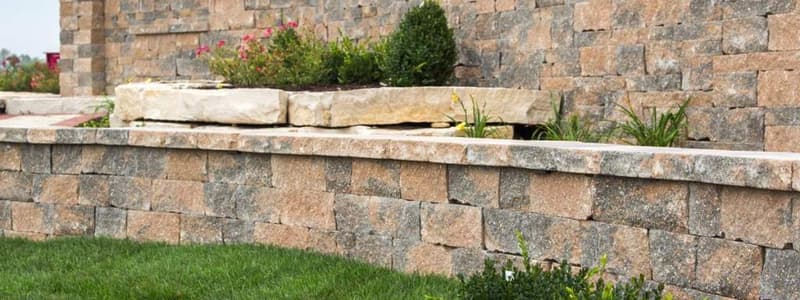Podcast
Questions and Answers
What is the purpose of installing an interlocking concrete block retaining wall?
What is the purpose of installing an interlocking concrete block retaining wall?
- To serve as a functional backdrop for outdoor features
- To create additional usable space (correct)
- To enhance the property's aesthetic appeal
- To reduce soil erosion
How are interlocking concrete wall blocks designed to fit together?
How are interlocking concrete wall blocks designed to fit together?
- By stacking on top of each other
- Like a puzzle (correct)
- Through welding
- Using adhesive material
What are the interlocking concrete wall blocks composed of?
What are the interlocking concrete wall blocks composed of?
- Cement and aggregate mixture (correct)
- Steel and concrete mixture
- Clay and sand mixture
- Brick and mortar mixture
What is the primary function of a retaining wall?
What is the primary function of a retaining wall?
How are concrete blocks laid to form the wall?
How are concrete blocks laid to form the wall?
In what condition are the concrete blocks molded?
In what condition are the concrete blocks molded?
What is the final step in building a retaining wall according to the text?
What is the final step in building a retaining wall according to the text?
What should be used to cut the blocks when reaching the end of the retaining wall?
What should be used to cut the blocks when reaching the end of the retaining wall?
What type of pattern should the interlocking concrete block retaining wall units remain in?
What type of pattern should the interlocking concrete block retaining wall units remain in?
What should be done with the coping units once the wall has been built?
What should be done with the coping units once the wall has been built?
What is recommended to prevent the “drainage zone” from getting clogged up with soil behind the retaining wall?
What is recommended to prevent the “drainage zone” from getting clogged up with soil behind the retaining wall?
What are Unilock heavy-duty wall blocks designed to provide for retaining walls?
What are Unilock heavy-duty wall blocks designed to provide for retaining walls?
What is the purpose of using geotextile fabric or DriveGrid at the bottom of the trench?
What is the purpose of using geotextile fabric or DriveGrid at the bottom of the trench?
Why is it important to choose the right interlocking concrete block for a retaining wall?
Why is it important to choose the right interlocking concrete block for a retaining wall?
What is the role of a tongue and groove system in interlocking concrete blocks?
What is the role of a tongue and groove system in interlocking concrete blocks?
When is a retaining wall considered 'structural'?
When is a retaining wall considered 'structural'?
What is the minimum depth of the trench required for a 6-inch high block?
What is the minimum depth of the trench required for a 6-inch high block?
Why is it necessary to mark the layout using grade stakes and string lines before building the wall?
Why is it necessary to mark the layout using grade stakes and string lines before building the wall?
What should be done before laying the aggregate base for a retaining wall?
What should be done before laying the aggregate base for a retaining wall?
What is the purpose of using Universal Base Pad or U-Grip Base Pad during installation?
What is the purpose of using Universal Base Pad or U-Grip Base Pad during installation?
Why should there be a minimum of 18 inches of clear gravel separating the retaining wall from the soil embankment?
Why should there be a minimum of 18 inches of clear gravel separating the retaining wall from the soil embankment?
What is the function of a structural retaining wall?
What is the function of a structural retaining wall?
What role does concrete adhesive play in installing interlocking concrete blocks?
What role does concrete adhesive play in installing interlocking concrete blocks?
Flashcards
Interlocking concrete block retaining wall
Interlocking concrete block retaining wall
A wall built using blocks that fit together to create usable space and hold back earth.
Purpose of a retaining wall
Purpose of a retaining wall
To hold back earth from a higher grade and create usable space.
Composition of interlocking blocks
Composition of interlocking blocks
Made from a mixture of cement and aggregates for strength.
Construction layout
Construction layout
Signup and view all the flashcards
Method of laying blocks
Method of laying blocks
Signup and view all the flashcards
Molding condition of blocks
Molding condition of blocks
Signup and view all the flashcards
Final step in building a wall
Final step in building a wall
Signup and view all the flashcards
Cutting blocks
Cutting blocks
Signup and view all the flashcards
Block pattern
Block pattern
Signup and view all the flashcards
Coping units
Coping units
Signup and view all the flashcards
Drainage zone prevention
Drainage zone prevention
Signup and view all the flashcards
Heavy-duty wall blocks
Heavy-duty wall blocks
Signup and view all the flashcards
Geotextile fabric use
Geotextile fabric use
Signup and view all the flashcards
Choosing interlocking blocks
Choosing interlocking blocks
Signup and view all the flashcards
Tongue and groove system
Tongue and groove system
Signup and view all the flashcards
Structural retaining wall
Structural retaining wall
Signup and view all the flashcards
Minimum trench depth
Minimum trench depth
Signup and view all the flashcards
Compacting subsoil
Compacting subsoil
Signup and view all the flashcards
Base pad purpose
Base pad purpose
Signup and view all the flashcards
Clear gravel space
Clear gravel space
Signup and view all the flashcards
Function of structural retaining wall
Function of structural retaining wall
Signup and view all the flashcards
Role of concrete adhesive
Role of concrete adhesive
Signup and view all the flashcards




